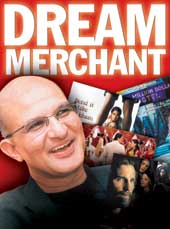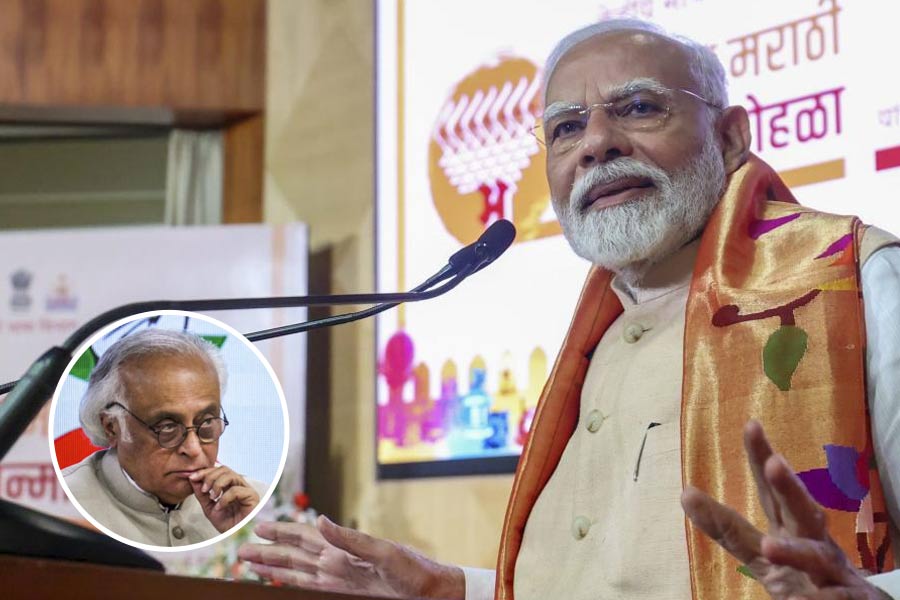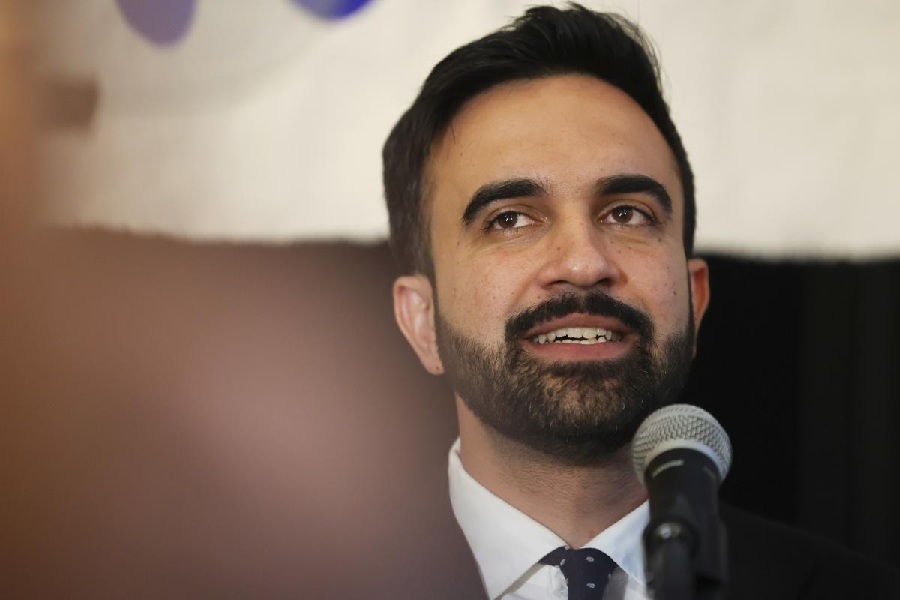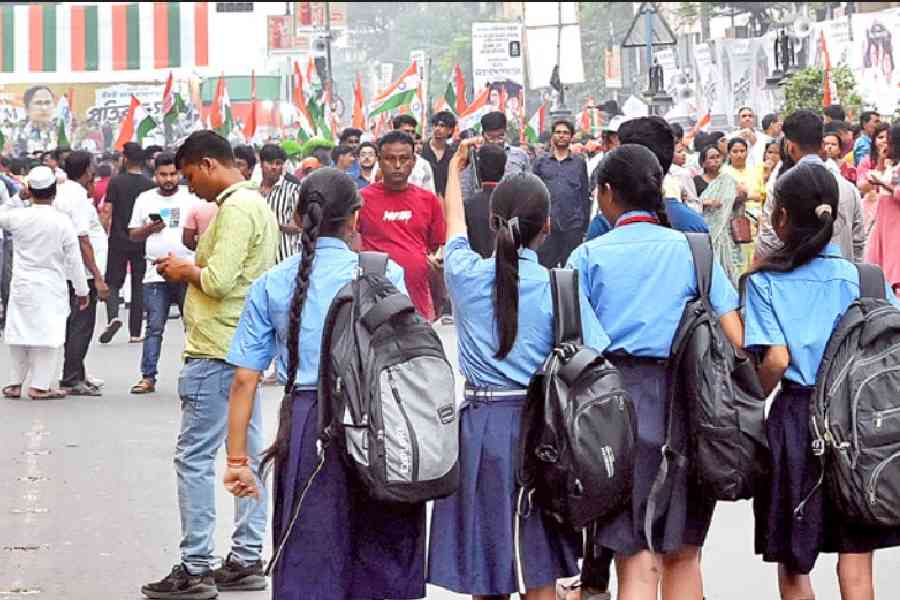 |
| FILM FARE: Deepak Nayar and an array of his success stories. Photo: Rajesh Kumar |
Imagine Aishwarya Rai and Gurinder Chadha at a plush restaurant in a big city where everyone knows them. Imagine Steven Spielberg sitting at a table nearby. A thin, bald man in a T-shirt walks in. He?s not a known face, nobody pays him attention. Till, Ash and Chadha rush to the door with open arms to greet him. Not just that, even Spielberg gets up to give him a bearhug.
?The best part is, everyone will ask, ?Who the hell was that guy??,? says Deepak Nayar with glee, for that?s the biggest kick he gets out of keeping a low profile. Nayar, 44, lets his work do the talking. For the uninitiated, his Hollywood production company Kintop Pictures has produced Bride & Prejudice. For those who know that and nothing else about him, he?s one of the biggest independent producers in Hollywood, with a life-story that would make a full-length tearjerker.
Now, dressed in a crumpled blazer, over a breakfast of porridge and fruit at the Taj Mahal Hotel in Delhi, where he?s checked into one of its best suites, the LA-based billionaire happily looks back on his hour-long bus rides from Panipat to reach school in Karnal. ?Ah, that was some quality time I spent with girls,? he says, before admitting he ?likes girls, period?. But not like Playboy?s Hugh Hefner, he?s quick to add, for he?s happily married (wife Mary is a short-story writer) with two kids.
Aishwarya Rai is a confidante, Gurinder Chadha a friend. He?s got Neve Campbell to agree to star in his next project, Sacred Thread, to be directed by Mahesh Mathai of the Kintop-produced Bhopal Express fame. And when you know Nayar has distributed The Passion Of The Christ in India, produced the Mel Gibson-starrer, The Million Dollar Hotel, and filled in when ?Mel? wouldn?t come to India to meet the press ahead of Passion?s release, you know how big a royalty Nayar is in Hollywood.
He is still commuting, though ? all of 20 miles in LA to reach his Hollywood office. ?But I think about the old bus rides, and very romantically,? he says, his face lighting up.
Clearly, Nayar enjoyed himself ? in school and later in Delhi?s Hindu College. He was always a good coordinator, and remembers organising Jagjit Singh shows as a student, something that helped kickstart his career later. He also did some plays, but nothing, he says, to write home about.
Everyone in his family, including uncle and journalist Kuldip Nayar, thought he was good for nothing. He, like every other teenager, thought he would make a great actor. In 1980, when he was 19, he went to Mumbai in search of a dream. ?I was a struggling actor there for exactly 13 days,? he says. On the 14th day ? after two weeks on a bench at Bombay Central railway station ? he realised there were at least a million other wannabes in the city.
?That day, I went to meet director .P. Ralhan with a letter from my chacha (Kuldip Nayar),? he says. Ralhan took him in as a runner, the lowliest of the lowly in the film industry (the kind who serve tea and coffee to unit members) for his film, Pyaas. For seven months, he worked there without being paid. And then Nayar found himself being promoted to whistle-blower ? the job entailed blowing a whistle to tell dancers in a sequence when to stop ? for Saroj Khan?s troupe. He recalls how Khan wanted to ?chew him? once when he whistled at the wrong moment.
He reminded Khan of the incident during the filming of Bride & Prejudice for which she was choreographer, but she couldn?t remember it. ?She must have had to deal with so many daydreaming spot boys like me,? he says. Just like he asked Zeenat Aman (who was the heroine of Pyaas) during the filming of Bhopal Express if his face rang a bell. It didn?t.
Nayar, clearly, has a penchant for throwing his ex-runner status at people. ?It?s so shocking for them to see that a spot boy went to Hollywood, became a producer there, and has come back to make movies in which they?re working,? he laughs.
But, as the days went by, the faceless Nayar gradually began to find a foothold in Mumbai. Jagjit and Chitra Singh remembered him from his concert-organising days and took him under their wing. They got him a job as a paid runner ? a salary of Rs 350 a month ? for director Bhimsain. Nayar promptly asked his father, a doctor in Panipat, to stop sending him money. He stayed at a guest house at Rs 7 a night for a bed, had a second-class train pass which cost him Rs 25, and would have vada pao (50 paise a plate) for breakfast, lunch and dinner. On a good day, he?d have a glass of milk, which put him back by Re 1.
Bhimsain took a liking to Nayar and made him unit manager of sorts ? giving him a raise of Rs 150. Nayar promptly bought a first-class pass for Rs 70 and rented a flat. ?I thought life couldn?t be better,? he says.
Nayar?s career took a turn when he met documentary filmmaker Shama Habibullah who, impressed with his professionalism, recommended him to the makers of the film Gandhi. He worked as a second unit manager there, and then got his big break in Ismail Merchant?s Heat And Dust. Merchant took him in as unit manager, and since Merchant Ivory was a foreign production company, Nayar made almost Rs 5,000 a week. After Heat And Dust, the word spread. All foreign filmmakers shooting in India would come looking for him. He worked as second assistant director (AD) for the James Bond film Octopussy and as first AD for Far Pavilions. He was location manager for the Peter ?Toole starrer Kim. By then, he was making Rs 20,000 a week. And he was all of 23.
They still didn?t know him at home, but Nayar had started to make a name for himself in the foreign filmmakers? circuit. Hollywood was beckoning, and Nayar moved to the United States in 1984. Nayar asked a Hollywood producer, making a Bollywood-based television show in New York called Bombay Broadcasting, to start shows in LA and San Francisco, saying he would help produce them. The producer asked him to get advertisements for the next eight months. He flew down to LA, met everyone who was anyone in the Indian community there, chased them, and got the ads. He had arrived in Hollywood.
Nayar now owns production units in Delhi and equipment centres in Mumbai. He also plans to take up distribution in India. ?But I really want to start one-night shows of auteur films for the discerning Indian,? he reveals.
Life, though, wasn?t always this smooth. There was a time when Nayar lost all his money after raking it in with Bombay Broadcasting. He had a lavish lifestyle in LA, didn?t have anything in hand and ran into huge debts. But he sprang right back. He got into the restaurant business with his East India Grill in LA, which has now caught on. For a spell he was even director David Lynch?s driver. He also met Merchant again, and worked as production manager for Deceivers and The Perfect Murder. ?As the saying goes in Punjabi: Har taraande papad belney padtey hain. I had to do everything to survive,? he says.
And survive he did. Two years after he was broke, Nayar was back to being a producer. He started co-producing two-bit television serials from 1990, and in 1994, produced his first feature film, the David Pullman-directed End Of Violence. One of his early films, The Buena Vista Social Club, even received an Oscar nomination. ?But no one in India has heard of it. I want to remedy that.?
That won?t be a tough one, for Nayar is finally ? much to his dismay ? being recognised back home in India. Most, however, still see him as an appendage to Gurinder Chadha ? but who cares when he is raking in the moolah out of Bend it Like Beckham and Bride & Prejudice?
Chadha and he go back a long way. They met at a time when Chadha had her hands full with her film, What?s Cooking. He promised to manage her finances which had gone awry, she trusted him, and the rest is history. Nayar has co-produced all of Chadha?s later films and made a fortune out of Bend it Like Beckham. He?s also taking up her next project, The Mistress Of Spices.
Bride & Prejudice, despite the flak it?s got from critics, is doing well in London and in most centres in India. He has already recovered 60 per cent of his money.
He?s glad he didn?t become an actor. ?I can look at my films and say, ?I made so much money from that one?, instead of ?I was so young then,?? he smiles impishly. From spot boy with aspirations of stardom, he is the unspottable ? and unstoppable ? Hollywood producer. And he is not complaining, for it still leaves people asking: Deepak Nayar, who?










